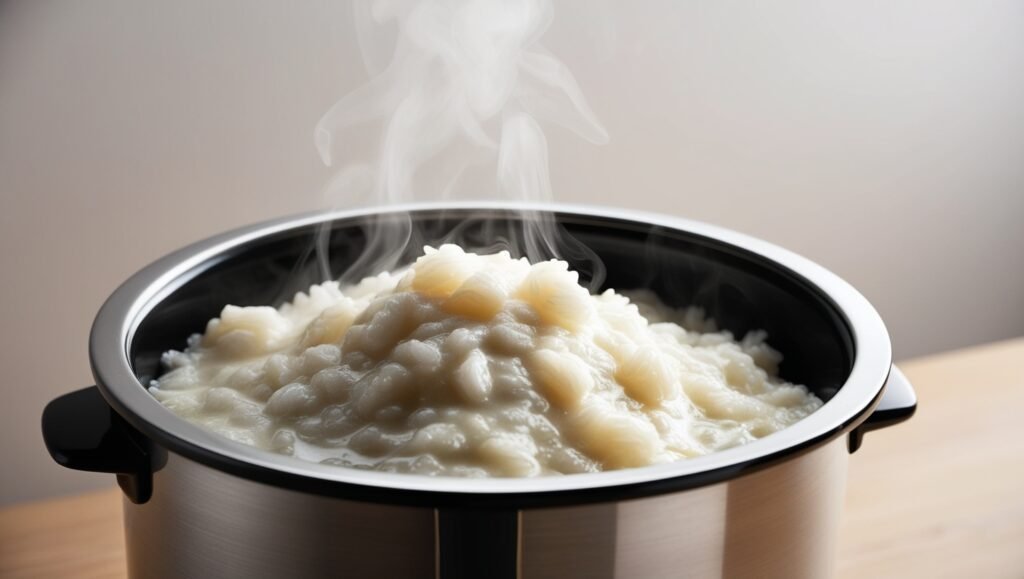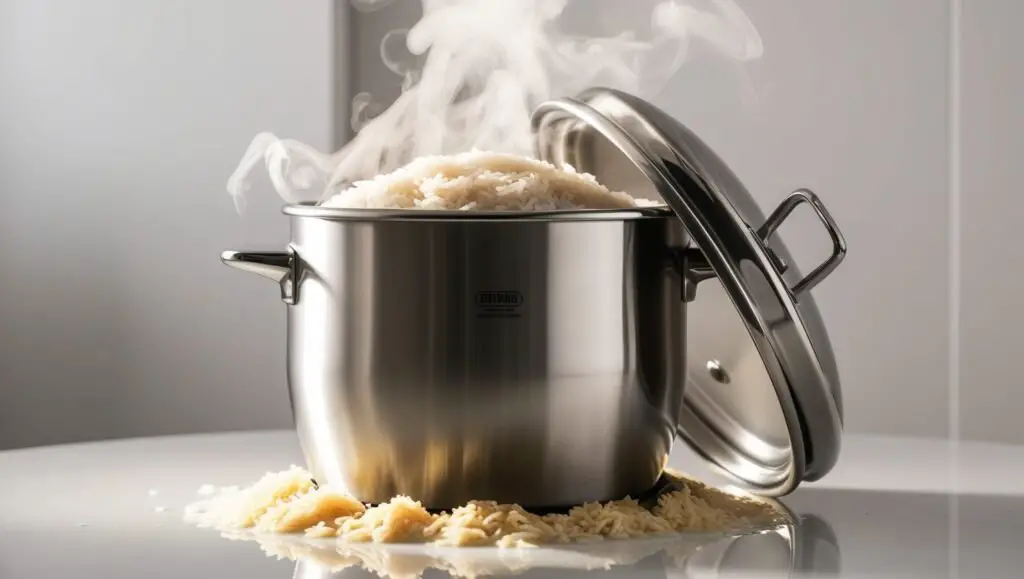Have you ever prepared a perfectly timed bowl of rice cooker bubbling over, foamy mess on your kitchen countertop? You’re not alone! I once stood bewildered, staring at my rice cooker as it spilled grains and water everywhere. In this post, I’ll share the reasons why your reliable kitchen appliance might let you down and how to keep your cooking area mess-free.
The Starch Factor: Why It Matters
Have you ever noticed your rice cooker bubbling over when cooking? It’s often tied to starch release during cooking. Starch is a carbohydrate found in various foods, including rice. When rice cooks, the heat causes the starch grains to swell and release into the cooking water. This release creates bubbles, and those bubbles can cause an overflow. It’s a common issue, but knowing a few tricks can help you manage it.
1. Starch Release and Bubbling
When rice is heated, the starch granules absorb water and expand. As they swell, they release more starch into the water. This can lead to bubbling. The result? A chaotic kitchen scene with rice spilling over the sides of your pot. Nobody wants that! Keeping an eye on your cooking process is very important.
2. Rice Varieties and Their Starch Levels
Not all rice is created equal. Some varieties are higher in starch than others. For instance:
- White rice: Typically high in starch.
- Brown rice: Generally contains less starch.
- Jasmine and Basmati: These often have varying starch levels based on their type.
When selecting rice, it’s useful to consider how its starch content might impact your cooking, especially if you’re prone to bubbling over.
3. Tips to Rinse for Less Starch Buildup
Have you tried rinsing your rice before cooking? It’s a simple step that can greatly reduce starch buildup. Rinsing rice helps wash away some of the excess starch, leading to a fluffier end product. Here are some easy steps:
- Place rice in a fine mesh strainer.
- Run cold water over it, stirring gently.
- Continue until the water runs clear.
This technique is not just practical; it’s one of those simple tricks for successful cooking. As a culinary expert once said:
By incorporating this step, you can enjoy perfectly cooked rice without the unwanted mess.
So, the next time you’re preparing rice, remember: understanding starch and how it affects your cooking can significantly reduce those bubbling issues.

Water-to-Rice Ratio Explained
When cooking rice, getting the right water-to-rice ratio is vital. It directly affects the texture and flavor of your dish. Ever tried rice that’s too mushy or dry? Not fun, right? Here are some key points to consider.
Common Ratios for Different Rice Types
Different types of rice require different amounts of water. Here’s what I’ve learned:
- White Rice: For every cup of white rice, use 1.5 cups of water.
- Brown Rice: For each cup of brown rice, you need 2 cups of water.
You might be wondering why brown rice needs more water. It has a tough outer layer, which makes it absorb water at a slower pace. Now, let’s take a close look at the table below to make this clear:
| Type of Rice | Water Required |
|---|---|
| White Rice | 1 cup = 1.5 cups water |
| Brown Rice | 1 cup = 2 cups water |
Impact of Using Too Much Water
Ever cooked rice and found it’s a sticky, soggy mess? That’s the result of using too much water. Too much water can drown the natural flavors and make your rice more of a porridge. Yikes! It’s essential to stick to the right ratio to avoid this catastrophe.
Adjusting Water Levels Based on Rice Variety
It’s not just white or brown rice; other grains like quinoa require different amounts too. Did you know that quinoa generally needs a 2:1 water ratio as well? Each grain has its quirks. So, adjusting water levels based on the type you’re cooking will yield the best results.
Maintaining the proper water-to-rice ratio is crucial for ideal cooking results. Knowing these simple techniques can elevate your rice game. Happy cooking!
Overfilling: The Hidden Culprit
Understanding Your Rice Cooker’s Capacity
Every rice cooker comes with specific limits. You might think, “What’s the big deal? A little extra won’t hurt.” But overfilling can lead to disaster. Most cookers have marked lines showing the maximum amount of rice and water they can handle. When we push these limits, we risk a messy kitchen. It’s like trying to stuff too many clothes into a suitcase – something’s bound to spill out.
How Overfilling Leads to Spills
Imagine boiling a pot of water. If you fill it to the top, you know what happens, right? It bubbles over and creates a mess. The same principle applies when we overfill our rice cookers. When the rice cooks, steam builds up. If the cooker is full, that steam has nowhere to go. Cue the spills. Overfilling your rice cooker can lead to:
- Overflowing contents
- Messes on your countertop
- Longer clean-up times
How to Gauge Quantities for Cooking Without Overflow
So, how do we avoid this? It’s simple! Start by measuring your rice. Most cookers require a certain ratio, typically 1 part rice to 2 parts water. If you’re in doubt, it’s always better to underfill than to risk a messy kitchen – Kitchen Guru. Here are some quick tips:
- Check for the fill lines on your rice cooker.
- Use a measuring cup for accuracy.
- If unsure, cook in smaller batches.
- Consider the type of rice – some varieties expand more than others.
By following these steps, we can enjoy perfectly cooked rice without the headache of cleaning up spills. Remember, cooking should be fun, not a chore! Keeping these tips in mind will help ensure a simple, enjoyable experience.
Maintain Your Rice Cooker: A Key to Success
Every rice cooker needs a little TLC. Regular cleaning and maintenance are essential for optimal performance. After all, nobody likes a cooker that bubbles over or leaves rice burnt at the bottom. So, what can we do to keep our trusty kitchen appliance working well?
Regular Cleaning and Maintenance Tips
- Always unplug your rice cooker before cleaning. Safety first!
- Use a soft sponge and mild detergent to clean the pot. Avoid abrasive pads.
- Wipe down the outer surface with a damp cloth. This keeps it looking new.
- Check the steam vent for any clogs. A clear vent is crucial for proper functioning.
Remember, “A clean rice cooker is a happy rice cooker!” – Home Chef. This saying resonates with what we often experience. A well-maintained rice cooker means less hassle when cooking.
How Residue Buildup Can Affect Performance
Did you know that leftover rice and debris can actually harm your appliance? When residue builds up, it doesn’t just look bad—it affects cooking performance. You may notice:
- Your rice isn’t cooking evenly.
- Longer cooking times or inconsistent results.
- Unpleasant odors emanating from your cooker.
Over time, these issues can lead to mechanical failures. Frequent cleaning can greatly reduce these risks.
Signs That Your Rice Cooker Needs Repair
Sometimes, despite our best efforts, we may notice our rice cooker acting strangely. Here are some signs to watch for:
- Unusual noises while cooking.
- Burnt rice on the bottom, even with regular cleaning.
- Indicator lights not functioning properly.
These could indicate a need for professional repair. It’s better to be safe than sorry.
In conclusion, keeping your appliance in shape ensures optimal performance and minimal mess. Regular care results in consistently delicious rice, reducing the likelihood of kitchen disasters.

Frequently Asked Questions
Why Does Rice Cook Differently in a Rice Cooker?
The magic of a rice cooker lies in its design. Unlike a regular pot on the stove, a rice cooker regulates temperature and moisture levels automatically. This means it can create the perfect environment for rice to cook consistently. Doesn’t that sound great? When water boils in a traditional setting, it can escape quickly. However, in a rice cooker, the steam is trapped, ensuring every grain cooks evenly. So, if your rice is fluffy and perfectly cooked, now you know why!
Is It Normal for Rice Cookers to Bubble?
Absolutely! Many users see bubbling and frothing in their rice cookers. It’s just the steam escaping during cooking. But why does this happen? Rice contains starch, which, when heated, creates bubbles. This could result in a slight overflow, so it’s wise to monitor it. If your rice cooker is bubbling over, don’t panic! It’s part of the cooking process. Just keep an eye on things to avoid a sticky situation.
How Can I Salvage Rice If It Overflows?
Oh no, rice overflow can be a real headache! But fear not, I have some handy tips for you:
- Act Quickly: Turn off the cooker immediately.
- Remove the Lid: This helps steam escape and reduces overcooking.
- Serve Immediately: Scoop out the rice while it’s still warm.
- Add Water Carefully: If the rice seems dry, add a splash of water and stir gently.
Many have asked me about rice overflow, and it’s a common issue with solutions. Remember, cooking mishaps happen to everyone. What matters is how you handle them!
Conclusion
An FAQ section can be a great resource for beginners and seasoned cooks alike. Addressing common worries helps ease the minds of those less experienced in the kitchen. By answering questions like why rice cooks differently in a rice cooker, what to do when it bubbles, and how to salvage overflowing rice, we can build confidence. So the next time your rice cooker bubbles over, just know that it’s a simple issue, and with a few tricks, you can still enjoy perfectly cooked rice. Don’t stress; cooking is about learning and adapting. We’re all in this together, so let’s keep cooking!
